Our father was a prolific artist during his life. Many of his works are cherished possessions that have found their way into our homes. Unfortunately, we have limited room and can’t display all the works he created. We have 38 of his works of art and other collected artifacts of his that have limited commercial value, but considerable sentimental value. Rather than auctioning or selling these remaining pieces, we would like to give away Dad’s remaining artwork to friends and family who will enjoy them. We invite you to review the items below and indicate which item(s) you would like.
PLEASE NOTE: While the items are free to you, we ask that you pay the approximate cost of packaging and shipping as shown. (For US recipients, the packing and shipping costs are: Tube-$60, Small-$110, Medium-$180, Large-$220, Extra Large-$500, Custom Box, if needed-$50… For Non-US recipients, we will notify you of the cost.)
Here is the process that we have in mind:
- Send an email with the subject “ARNOLD ART” to Marc.Arnold@LestWeForgetSculpture.org and include the following information:
- Your Name
- Your Shipping Address
- The Item Number and Description for each item you would like to own
- We will respond and let you know if the items are still available and specific payment instructions (via Zelle or check).
- Upon receipt of your payment, we will have UPS pack and ship the item(s), then provide you a tracking number.
It will give us great pleasure to know that Dad’s artwork is continuing to give people pleasure. We certainly know he would want that!
Marcie Barkin, Dana Schwartz and Marc Arnold
(scroll down to see items)
LONG-POSE FIGURE DRAWINGS
From an early age, Dad studied life drawing at the Chicago Art Institute. He loved the play of light on figures and enjoyed a lifetime of drawing. He used a variety of media, but his favorite was charcoal and conté crayon. During the mid-1970’s, he created a series of more than 100 large original drawings. Each of these long-pose drawings were done over the span of several modeling sessions, often taking more than a week to complete. When he was done, a prominent art gallery in Los Angeles hosted a one-man-show consisting of 60 drawings from this series. Dad was pleased that fifty-nine sold. He was even more proud that one was stolen!
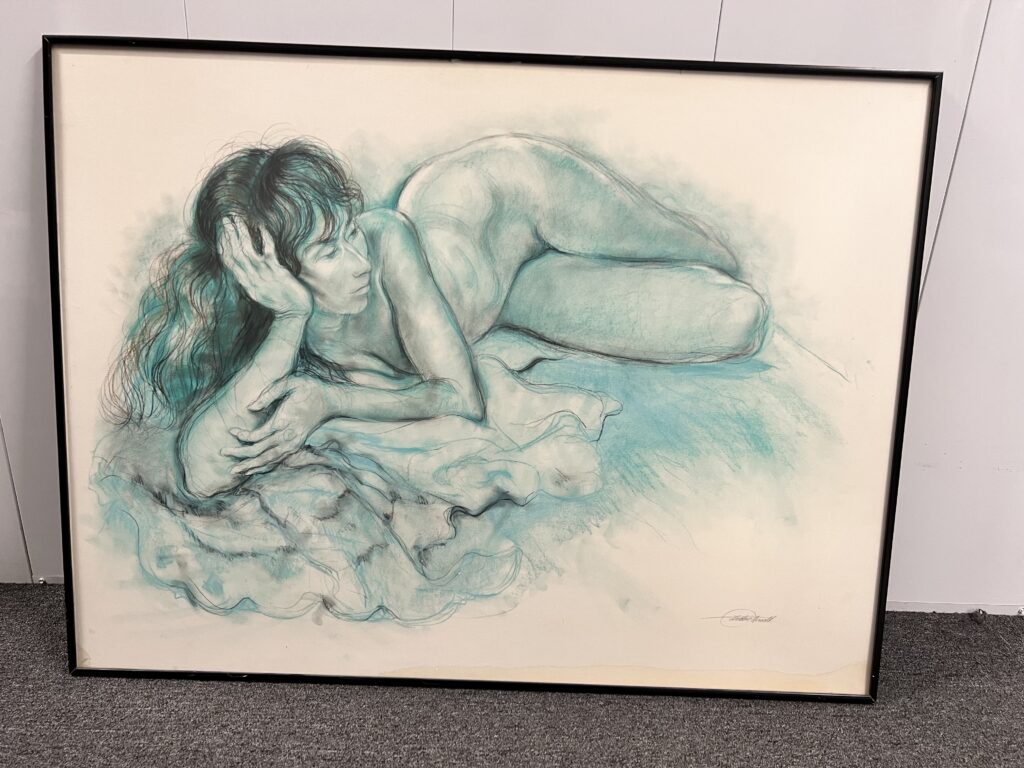
Item 1, Reclining Female Nude, Fredric Arnold, Charcoal and Conté Crayon, 40×31, (Packing and Shipping: Extra Large-$500)
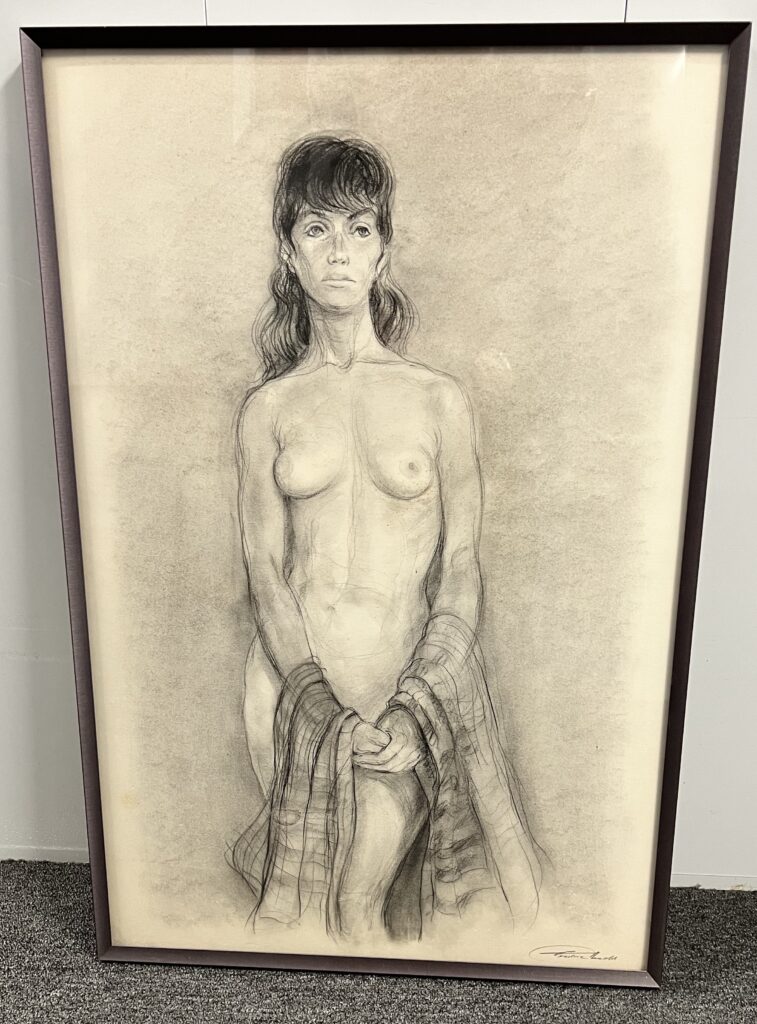
Item 2, Standing Female Nude, Fredric Arnold, Charcoal, 20 X 30, framed (Packing and Shipping: Large-$220)
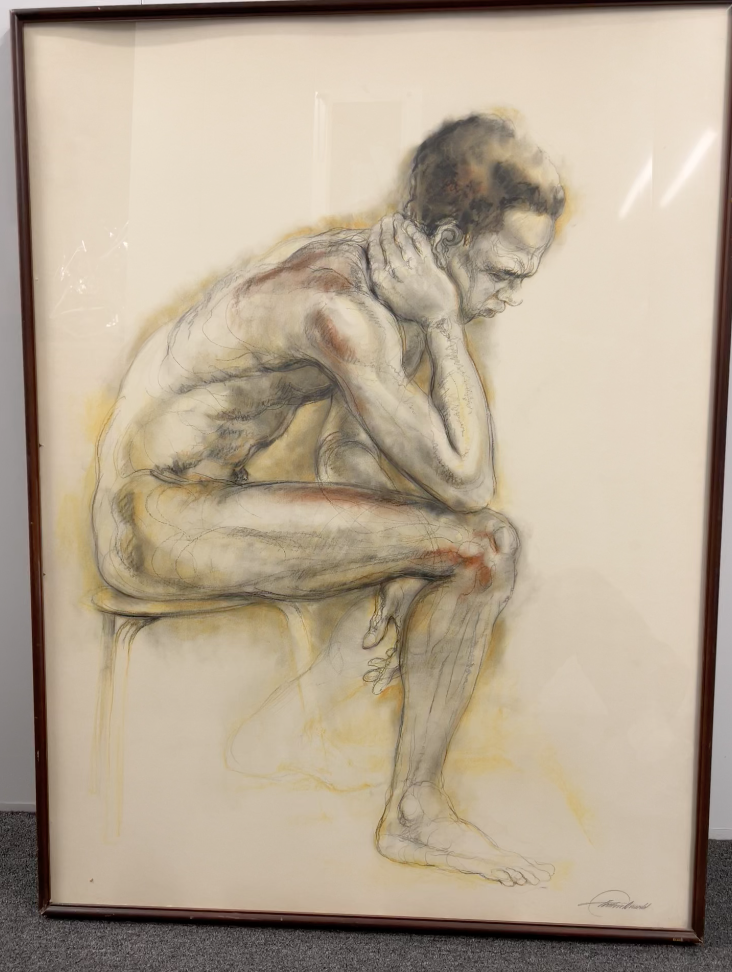
Item 3, Seated Male Nude, Fredric Arnold, Charcoal and Conté Crayon, 40×31 (Packing and Shipping: Extra Large-$500)
SHORT-POSE FIGURE DRAWINGS
In addition to long-pose drawings, he also enjoyed the challenge of short-poses. The following were done quickly, often in only an hour or two. These studies allowed him to test different poses, sometimes changing the model’s position during the drawing. They reveal his thinking as he sought to find the essence of each pose.

CLAIMED Item 4, Nude Study One, Fredric Arnold, charcoal, 19×24, unframed (Packing and Shipping: Small-$110)
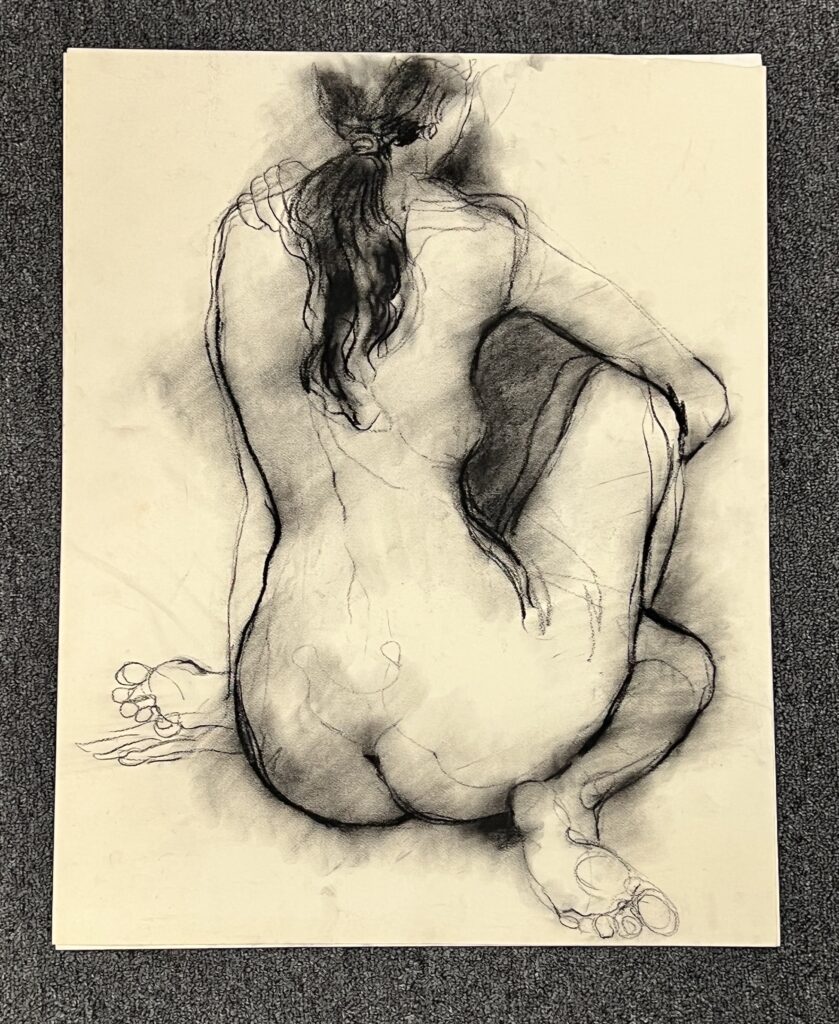
CLAIMED Item 5, Nude Study Two, Fredric Arnold, 24×18, charcoal, unframed (Packing and Shipping: Small-$110)
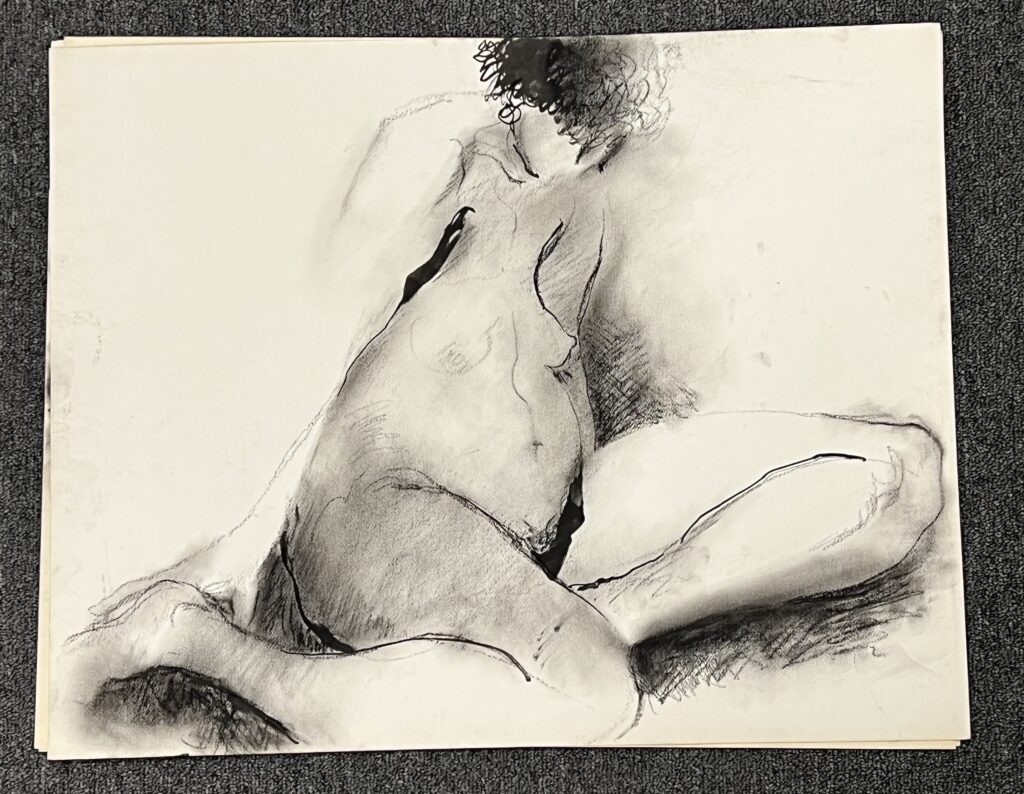
Item 6, Nude Study Three, Fredric Arnold, 24×18, charcoal, unframed (Packing and Shipping: Small-$110)
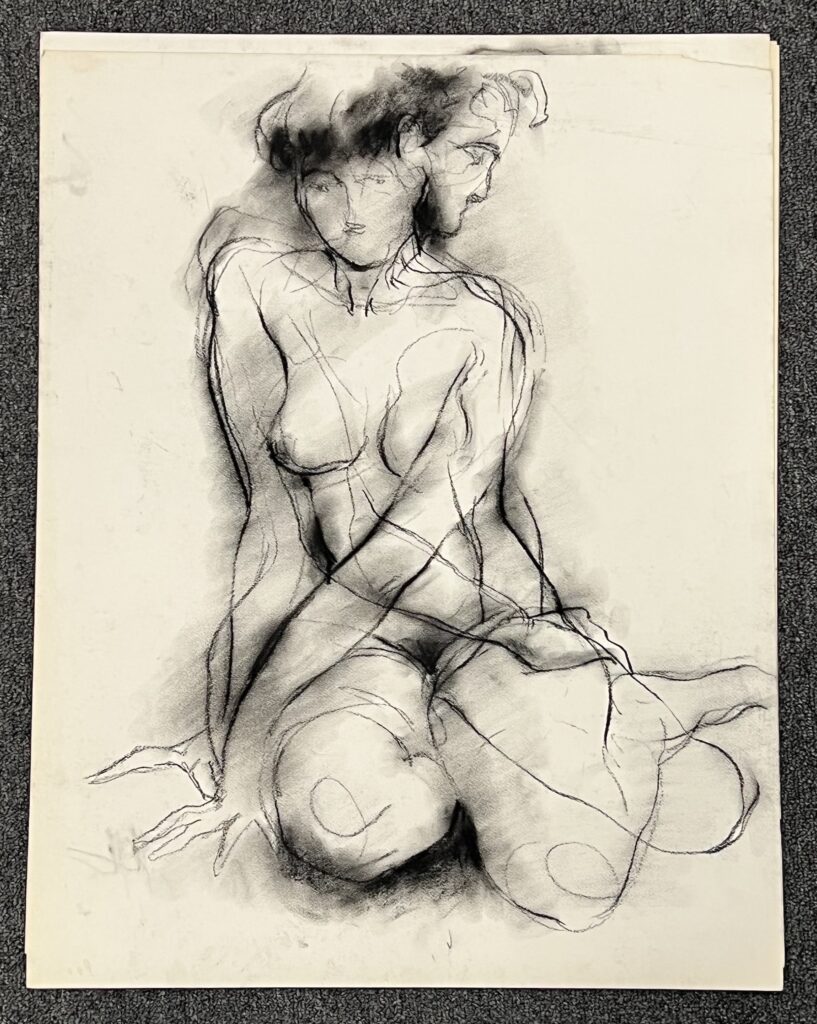
CLAIMED Item 7, Nude Study Four, Fredric Arnold, 24X 18, charcoal, unframed (Packing and Shipping: Medium-$180)
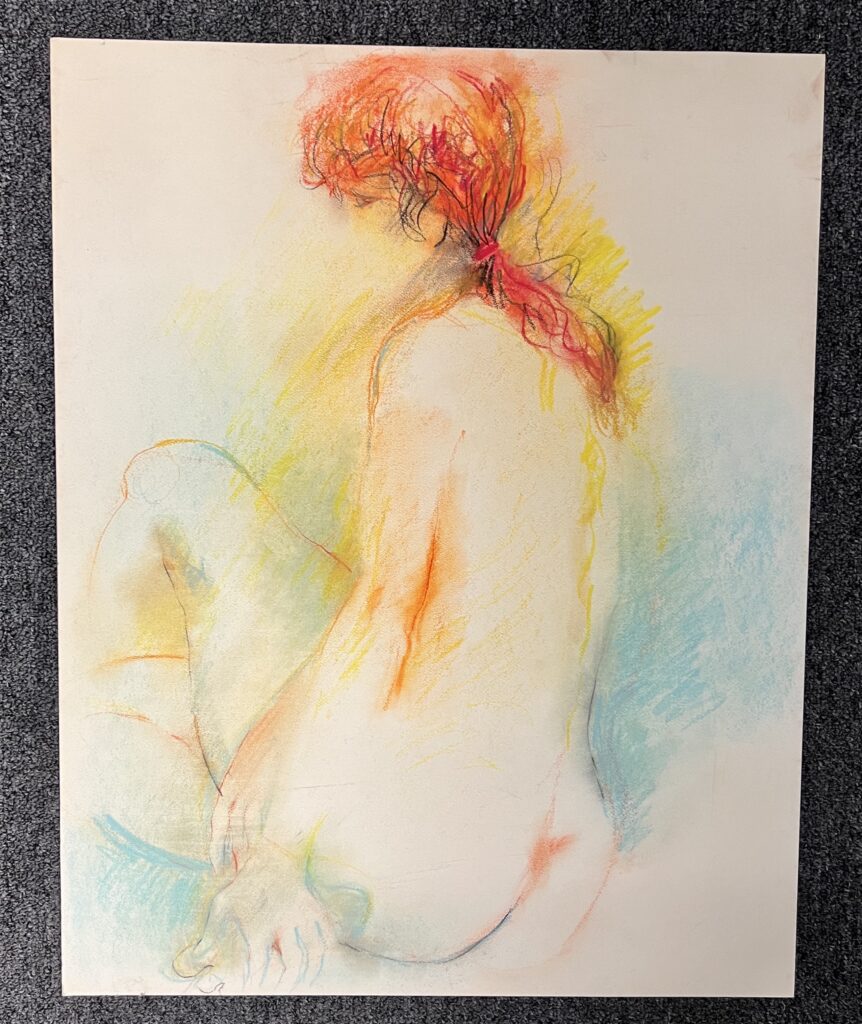
CLAIMED Item 8, Nude Study Five, Fredric Arnold, Pastel, 19 x 24, unframed (Packing and Shipping: Small-$110)

Item 9, Nude Study Six, Fredric Arnold, Pastel, 19 X 24, unframed (Packing and Shipping: Small-$110)
THE LÉGER PERIOD
During a European vacation in 1982, Mom and Dad visited a museum featuring the work of Fernand Léger (1881-1955). Dad was smitten by the “freedom” of Léger’s style. After a lifetime of realism, Dad explored new styles. Over the next decade, he developed a technique that combined lyrical bold lines with mixed media, often incorporating manipulated photographic images.
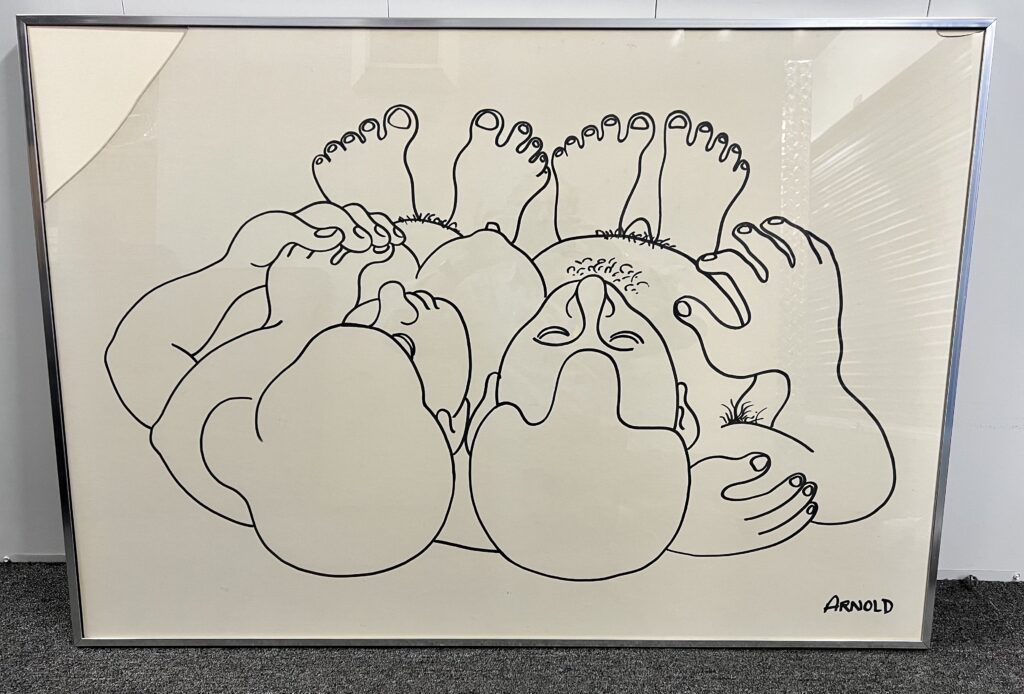
CLAIMED Item 10, Nat and Fred, Arnold, Ink, 30 X 43, framed/no glass (Packing and Shipping: Extra Large-$500)

Item 11, Sunbathing with Magazines, Fredric Arnold, 31×41, mixed media, framed, some yellowing (Packing and Shipping: Extra Large-$500)
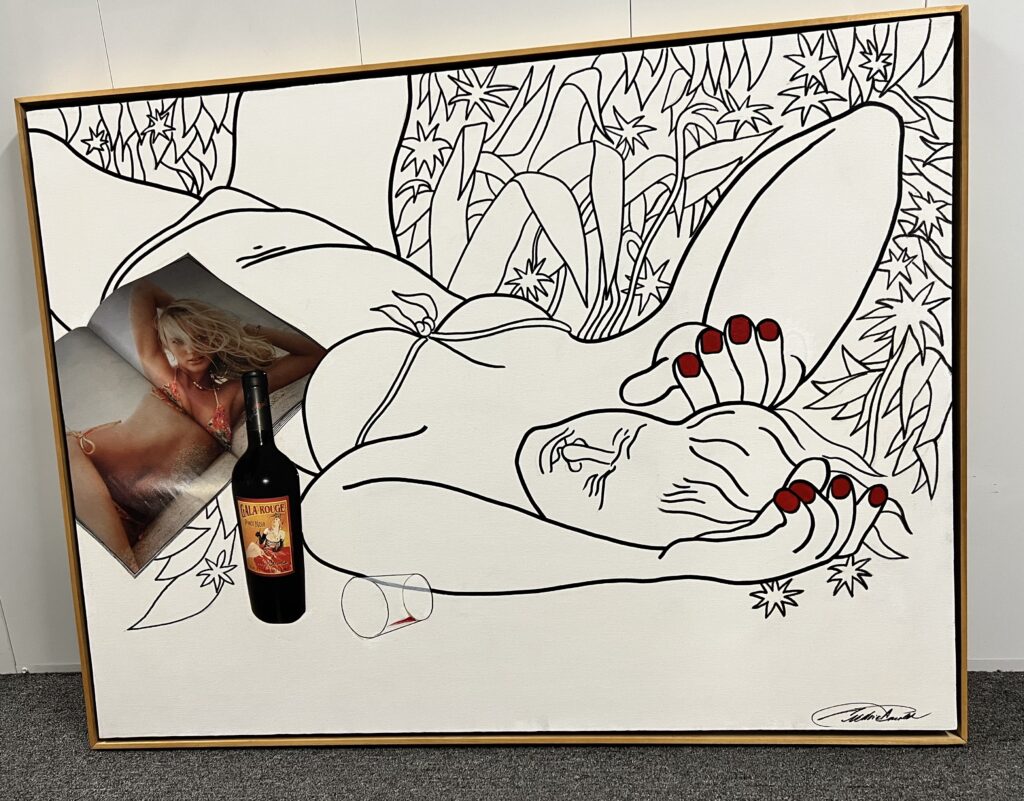
Item 12, Sunbathing with Wine, Fredric Arnold, 41×31, mixed media, framed (Packing and Shipping: Extra Large-$500)

Item 13, French Couple, Fredric Arnold, 37×49, mixed media, Framed (Packing and Shipping: Extra Large, plus Custom Box-$550)

Item 14, The Bridge Game, Fredric Arnold, mixed media, 31×41, framed (Packing and Shipping: Extra Large-$500)
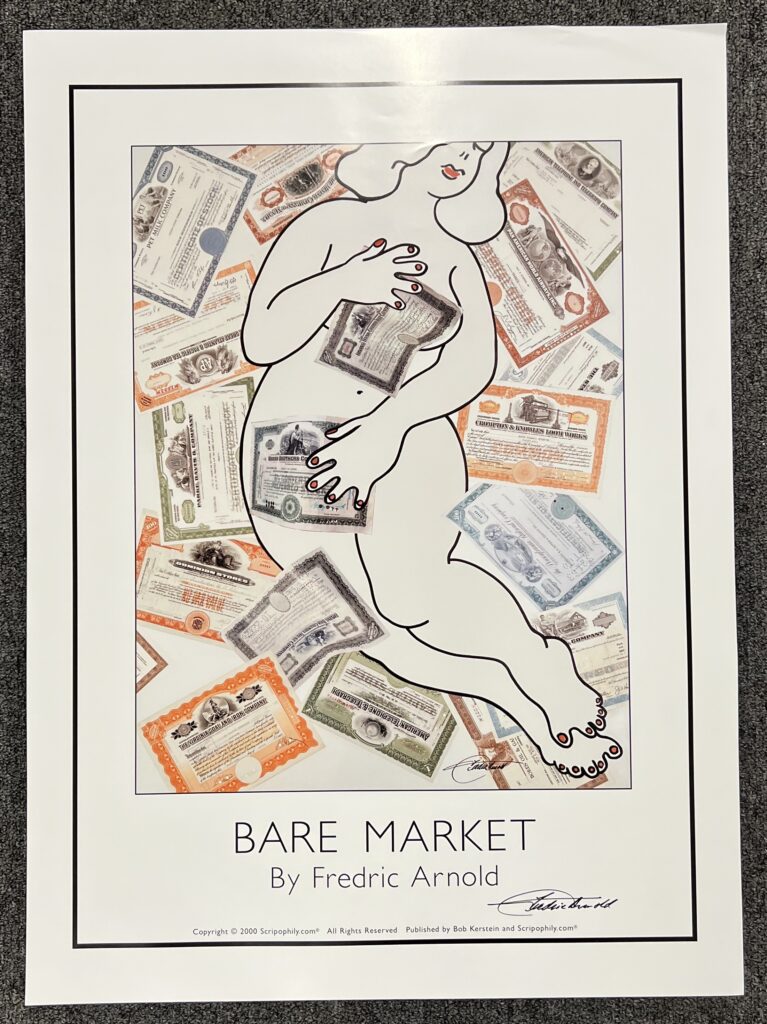
Item 15, Bare Market, Fredric Arnold, 20 x 27, Signed Lithograph, unframed (Packing and Shipping: Tube-$60)
Dad collaborated with family friend, Bob Kerstein, to create a whimsical figure partially clad in stock certificates. Bob is a purveyor of collectible stock certificates and provided the certificates that were incorporated in this work.
“LEST WE FORGET” SLIDE SHOW ENLARGEMENTS
Dad wrote his bestselling autobiographical novel, Doorknob Five Two, in 1984. As an author, he was asked to lecture to audiences in venues which included air shows, military bases, universities and large organizations such as NASA. He always strived to dispel any hint of glorification in relation to war. His talk was titled “World War II Wasn’t Fought by John Wayne.” In the early years, he used a Kodak Carousel projector to display an actual slide show. In later years, we converted the slides to a PowerPoint presentation. Over the span of decades, he spoke to tens of thousands of people in audiences across the country.
In 2012, David Pottruck invited Dad to deliver his talk at The Grove, an event organized by the prestigious Bohemian Club. Electronics were not permitted at the event, so Dad delivered his remarks using 32 by 23 inch enlargements. The descriptive notes below include the PowerPoint prompts Dad used during his talks. These unique enlargements are suitable for framing.
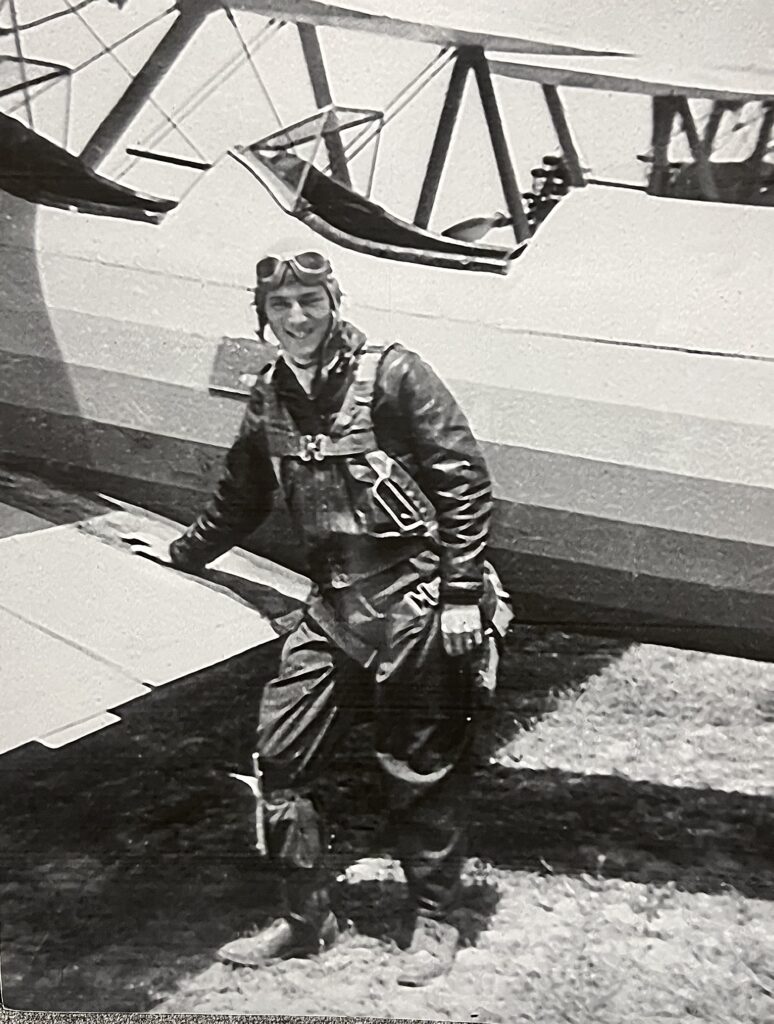
Item 16, Basic Training, Photograph, 23×32, unframed (Packing and Shipping: Medium-$180)
“In no time at all, I was getting trained to fly aircraft. It is hard to believe, but state-of-the-art flight training in those days started with fabric-covered open-cockpit biplanes!”

Item 17, P-38 with Drop Tanks, Photograph, 23×32, unframed (Packing and Shipping: Medium-$180)
“The P-38 only held one person: The pilot. As an artist, I was fascinated by its unique twin engine design with twin tailbooms flanking a central cockpit gondola. Even today, I think it is one of the most beautiful planes ever built. It was awesome… fully loaded, it weighed 9 tons… the two engines put out 3000 hp, and it had a top speed of 443 mph! That was a lot plane for guys like me who’d been civilians only a few months earlier.”
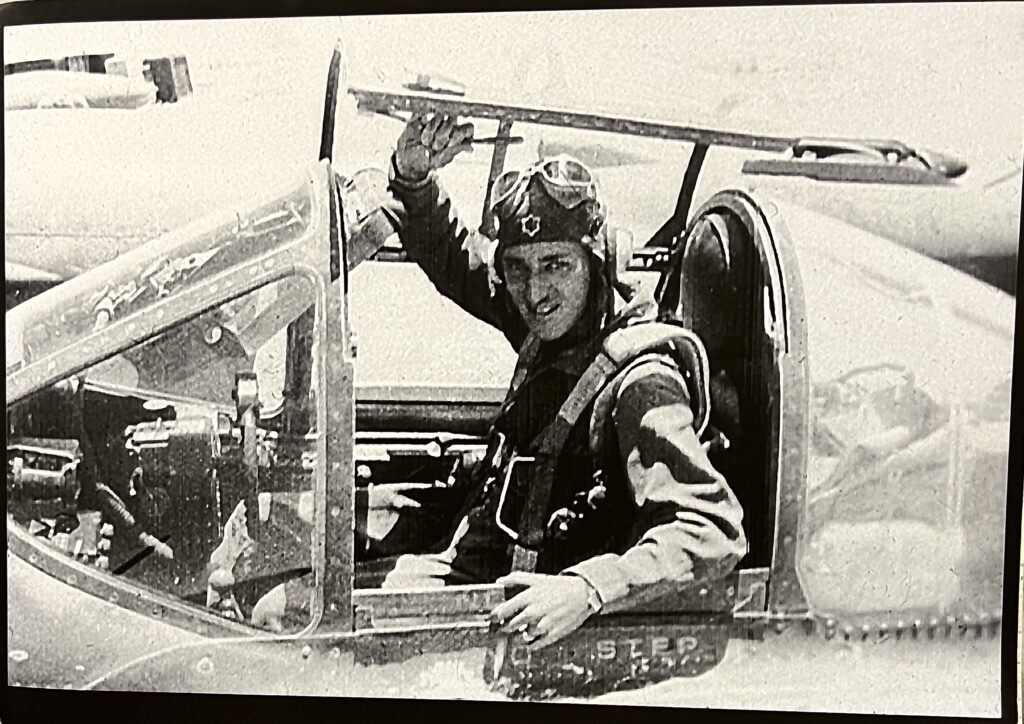
Item 18, North Africa, 1943, Photograph, 23×32, unframed (Packing and Shipping: Medium-$180)
“America was in a desperate rush to get planes and pilots into combat. Believe it or not, we were sent to fly combat with as little as 90 hours of total flight time. By today’s standards, this was a ridiculously small amount of training. But, hey, that’s what the circumstances demanded. So we did it. Here I am, supposedly ready for combat… In truth, I barely knew how to fly the plane!” (Note the Jewish star Dad had sewn on his helmet as described in his book.)
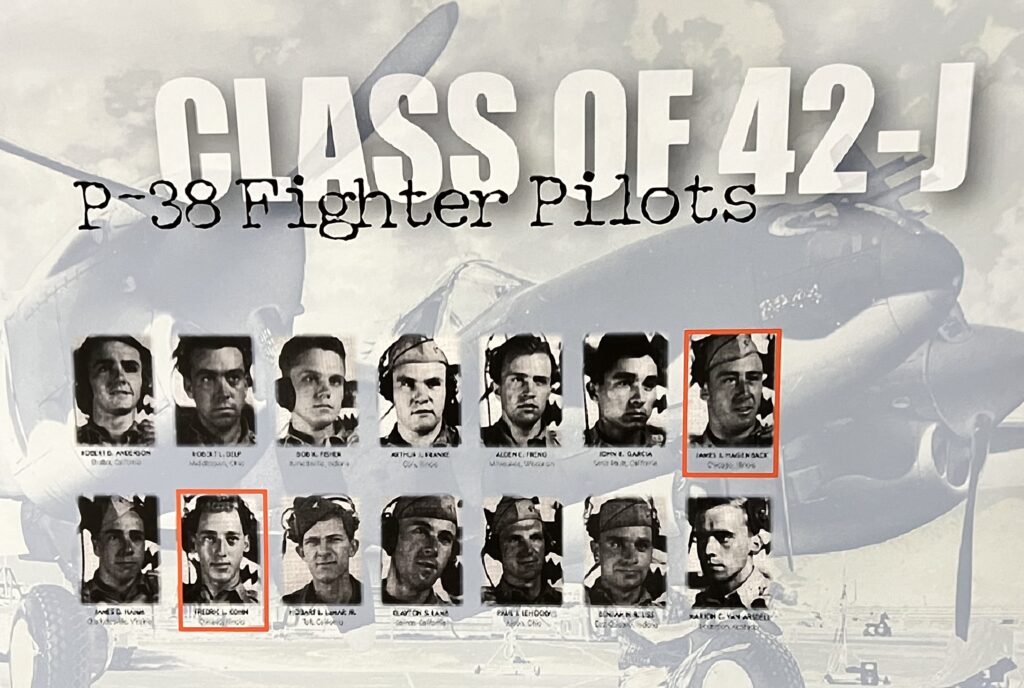
Item 19, Class of 42-J, Photograph, 23×32, unframed (Packing and Shipping: Medium-$180)
“On October 30, 1942, those of us who made it through the training program graduated with the rank of Second Lieutenant and were given our wings… There were 14 of us in our Group of the Class of 42-J that had been together from the very start. We intended to stay in touch whenever possible throughout the war. Little did we know what was in store for us. Six months later, only two of us were still alive.”
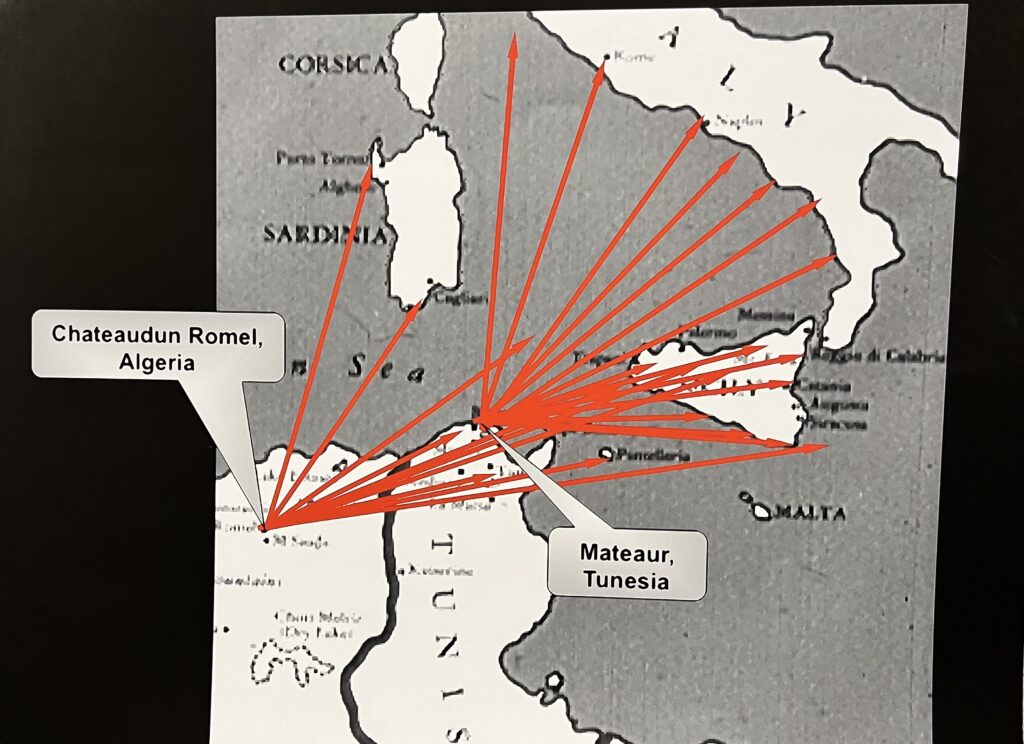
Item 20, Combat Missions, Photograph, 23×32, unframed (Packing and Shipping: Medium-$180)
“We had no time to figure anything out… We were shipped off to North Africa and immediately thrust into combat. Initially, we were told we could come back after 25 missions… Unfortunately, the average life expectancy of a fighter pilot early in the war was only 17 missions! Later, as some of us approached the magical 25th mission, the number was raised to 50 missions. At first, we flew missions from Algeria. Later we moved our base to Tunisia as Allied forces pushed Rommel out of Africa in preparation for the invasion of Sicily.”
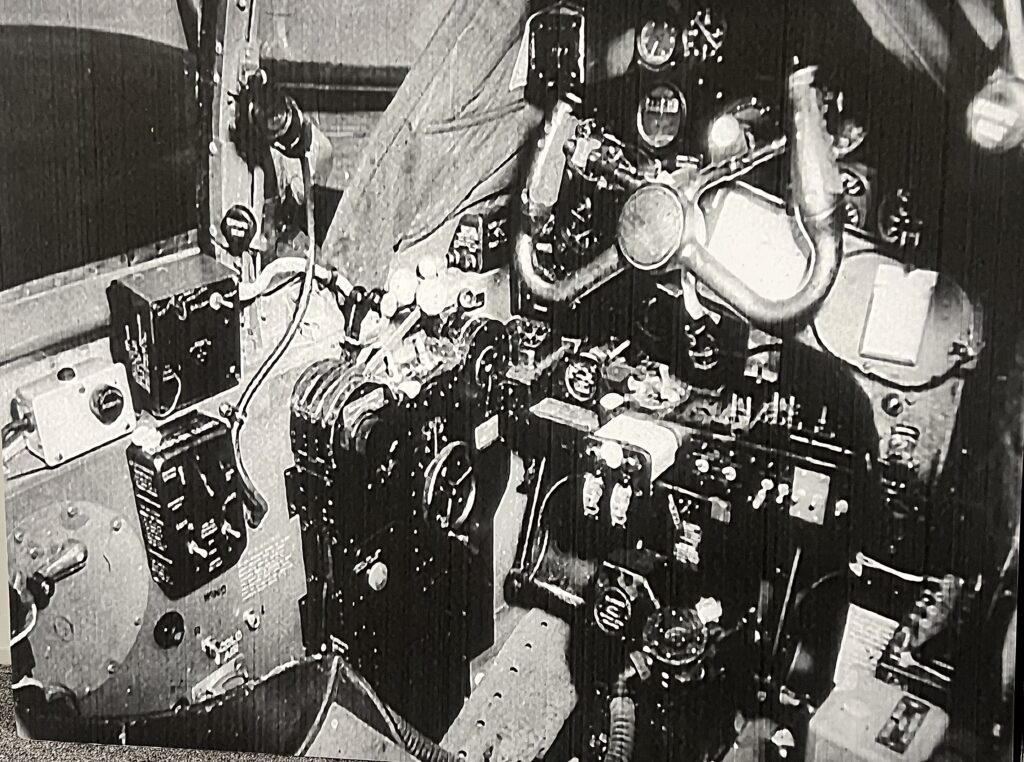
Item 21, P-38 Cockpit, Photograph, 23×32, unframed (Packing and Shipping: Medium-$180)
“After intense Primary Training in single-engine two-pilot biplanes, we moved to Advanced Training in faster single-engine two-pilot trainers. Then, we went to the single-seat twin-engine P-38 Lightning. We demonstrated our readiness to fly the plane by taking a ‘blindfold test’ — proving that we could find every control and instrument while wearing a blindfold. Then we were told to go fly it! The first time you flew the P-38, you were alone. A lot of guys didn’t survive the training.”
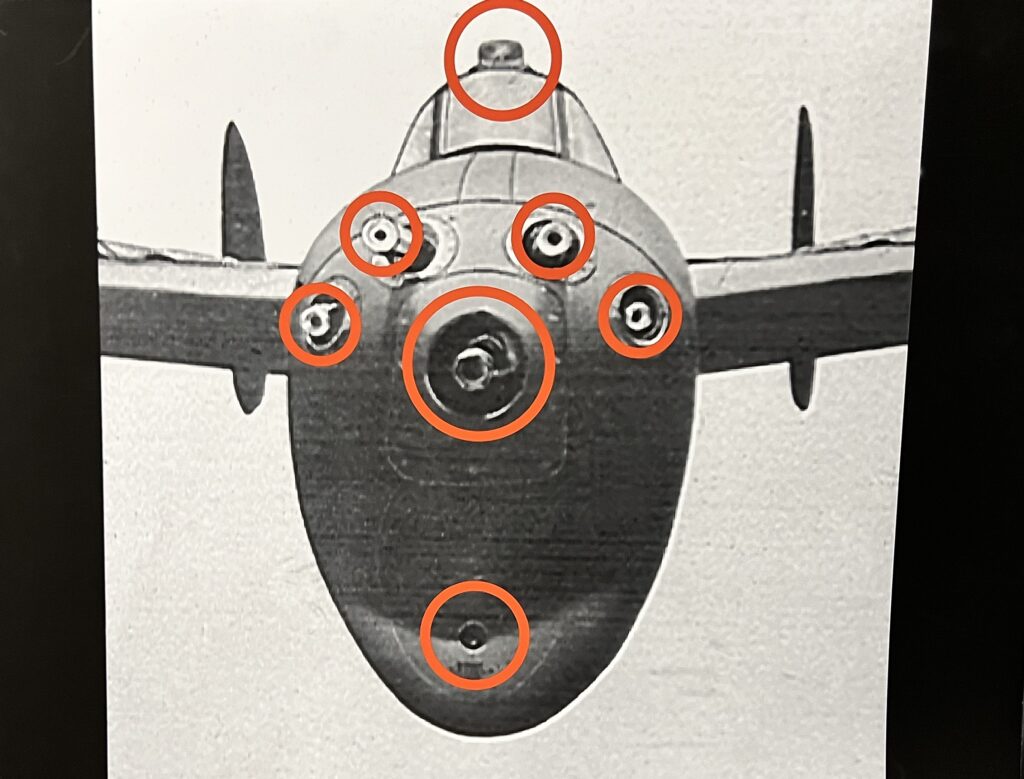
Item 22, P-38 Armament, Photograph, 23×32, unframed (Packing and Shipping: Medium-$180)
“We were equipped with awesome firepower… four fifty-caliber machine guns plus a 20mm cannon… all located in the nose. A movie camera mounted below the guns recorded the damage we inflicted. Up above the canopy, there was a rearview mirror that was supposed to give us a view of enemy fighters approaching from the rear, but it was useless. We looked behind us so often and so compulsively, the condition came to be known as the ‘Messerschmitt Twitch.'”
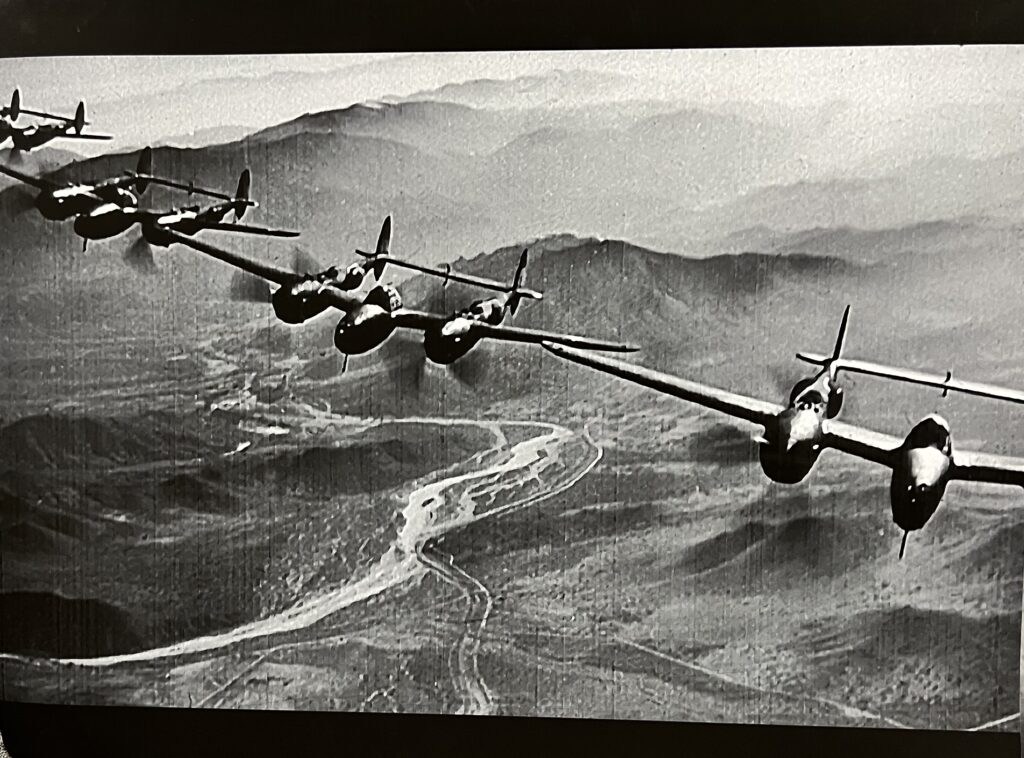
Item 23, Flight of Four, Photograph, 23×32, unframed (Packing and Shipping: Medium-$180)
“The P-38 had a reputation for being a difficult plane to fly, but that’s all wrong. It was a baby carriage! I hated combat, but I always loved flying that beautiful plane. This is a promotional photo was taken by Lockheed, the manufacturer, near the factory where they were built in Burbank, California. I flew fifty combat missions, 48 in the same plane. On the two missions that I was given a substitute plane to fly… I was shot down! You think I was superstitious? You better believe it! I was afraid to change my underwear!”

Item 24, Battle Damage, Photograph, 23×32, unframed (Packing and Shipping: Medium-$180)
“This is my plane after a rough mission. The elevator, rudder and left wing were chewed up by enemy fire. It was a testament to the durability of the plane and to dumb luck that I survived when so many guys didn’t. More than 88,000 U.S. airmen were killed in the war. We lost guys on almost every mission. It was Russian Roulette.”

CLAIMED Item 25, Crew Chief, Photograph, 23×32, unframed (Packing and Shipping: Medium-$180)
“Here I am with my Crew Chief, Chad. He jokingly ‘loaned’ the plane to me for each mission and told me to take good care of it and bring it back in one piece… ha ha. The maintenance crew waited anxiously while I flew the mission, then worked all night to ready it for the next day’s mission. Out of 50 missions, there were only two times they couldn’t repair my plane in time for the next flight. While other pilots named their planes for their girlfriends, I named mine after my father.”
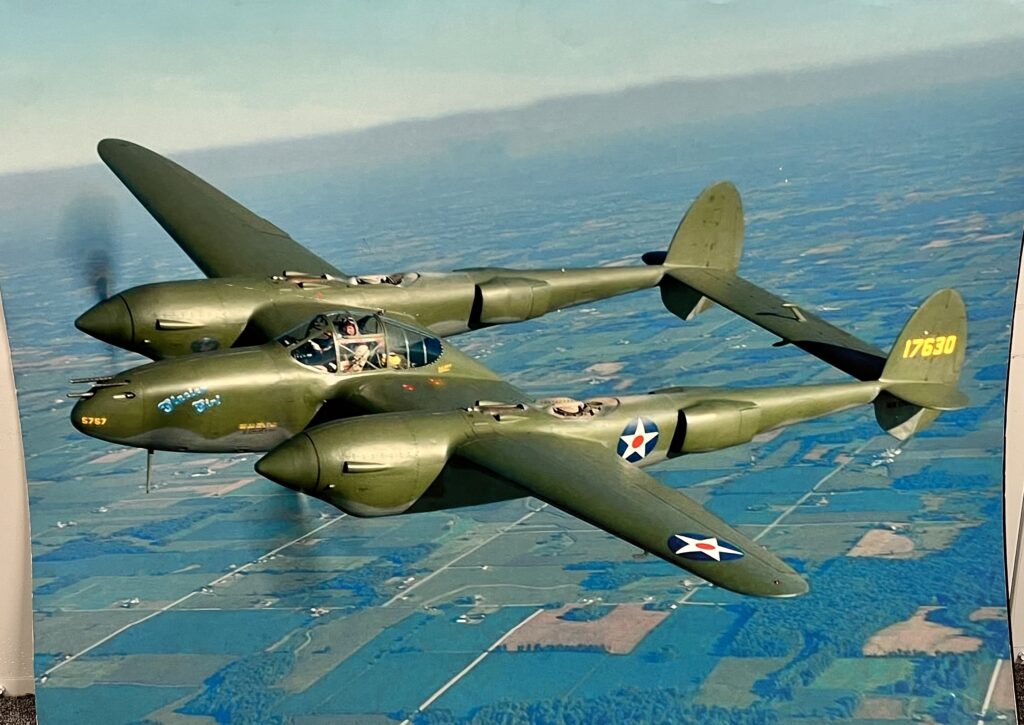
Item 26, Glacier Girl, Photograph, 23×32, unframed (Packing and Shipping: Medium-$180)
“During the war, pilots attempted to ferry a flight of six P-38’s and two B-17’s across the Atlantic from the U.S. to England. Bad weather forced them to make an emergency landing. They landed safely on the Greenland ice sheet and the men were rescued. Over the next fifty years, 250 feet of snow and ice accumulated, burying the planes. One of the P-38’s was excavated and restored to flying condition. It’s flying today and named Glacier Girl.”
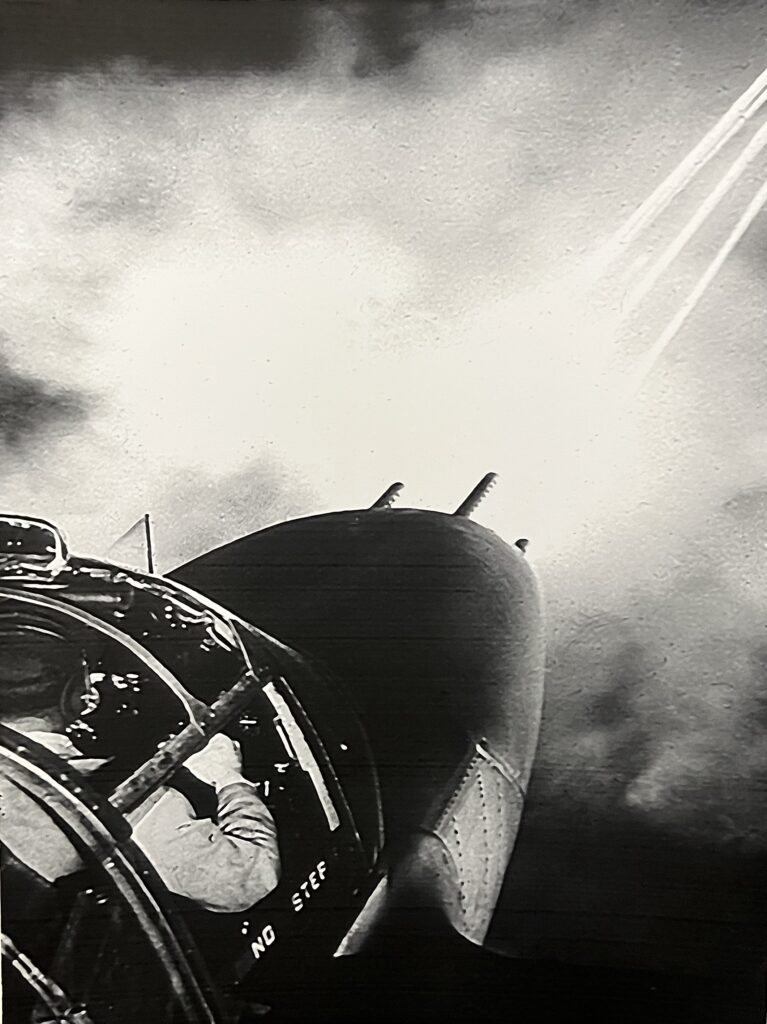
Item 27, Test Firing, Photograph, 23×32, unframed (Packing and Shipping: Medium-$180)
“During WWII, single engine fighters carried their machine guns in their wings. Those guns had to be canted inward so the bullets converged about 800 feet ahead of the plane. The P-38 had a distinct advantage: Because our guns were mounted in the nose, they could be pointed straight forward so they were equally effective at short-, mid- and long-range. Here is a dramatic view of test firing the guns on the ground to check their alignment. The brights streaks are tracer bullets.”
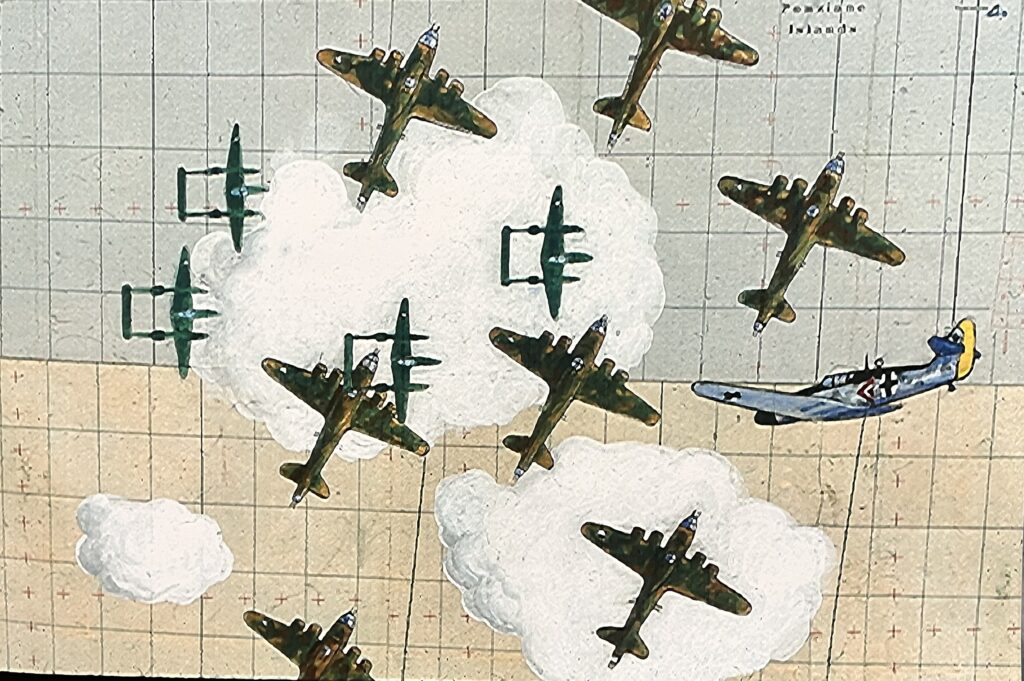
Item 28, Bomber Escort, Photograph, 23×32, unframed (Packing and Shipping: Medium-$180)
“Long after the war, I painted a large wall mural to memorialize the 12 men killed of my original Group. I pieced together the actual briefing maps from my time in combat to serve as a canvas and painted 20 vignettes to illustrate the kinds of missions we flew. This image conveys the chaos we encountered when enemy fighters dove down through our formation of P-38’s to attack the B-17 bombers below. Our job was to protect the bombers… but often it was a crazy mad house.”
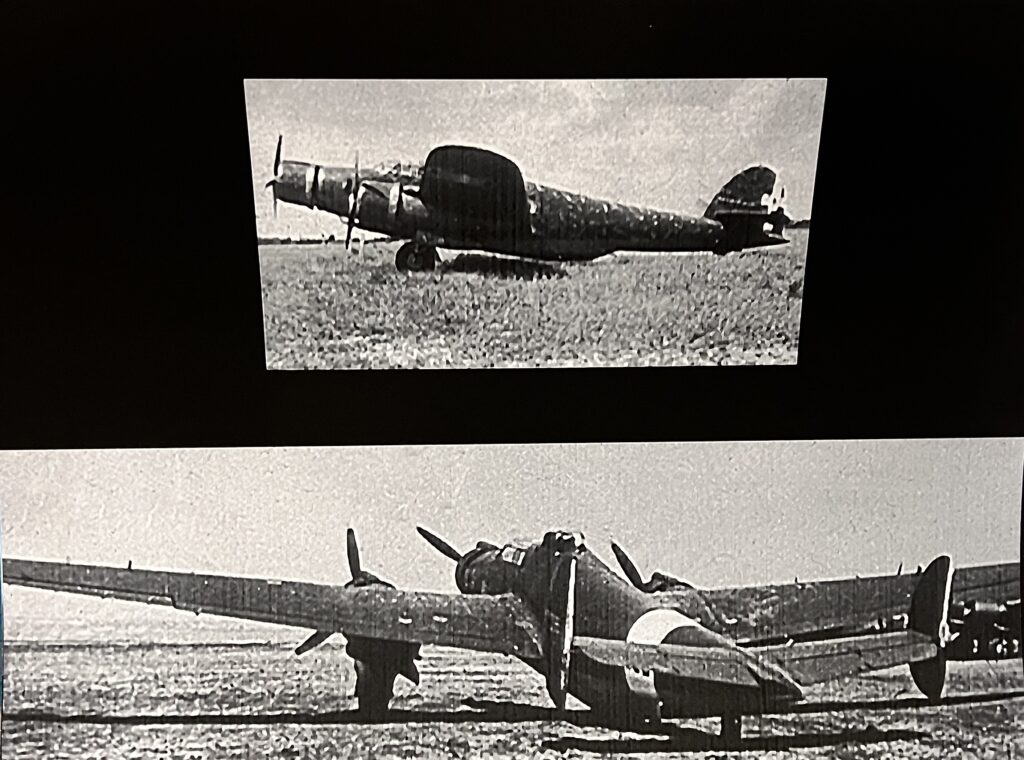
Item 29, Cantiere 1007, Photograph, 23×32, unframed (Packing and Shipping: Medium-$180)
“In April, 1943, I destroyed an Italian Cantieri 1007 three-engine aircraft not far from the shore of Tunisia. It was not very maneuverable and had no defenses. Shooting it down felt like an execution. Over the years, I couldn’t shake the feeling that it probably carried 8-10 retreating soldiers as we pushed Rommel’s forces northward. More than 50 years later, I was on a radio talk show and a marine called in to say eight of the men had managed to bail out and survived. He knew because his group captured them when they swam to shore. I cried with relief from the guilt I’d carried all those years.”
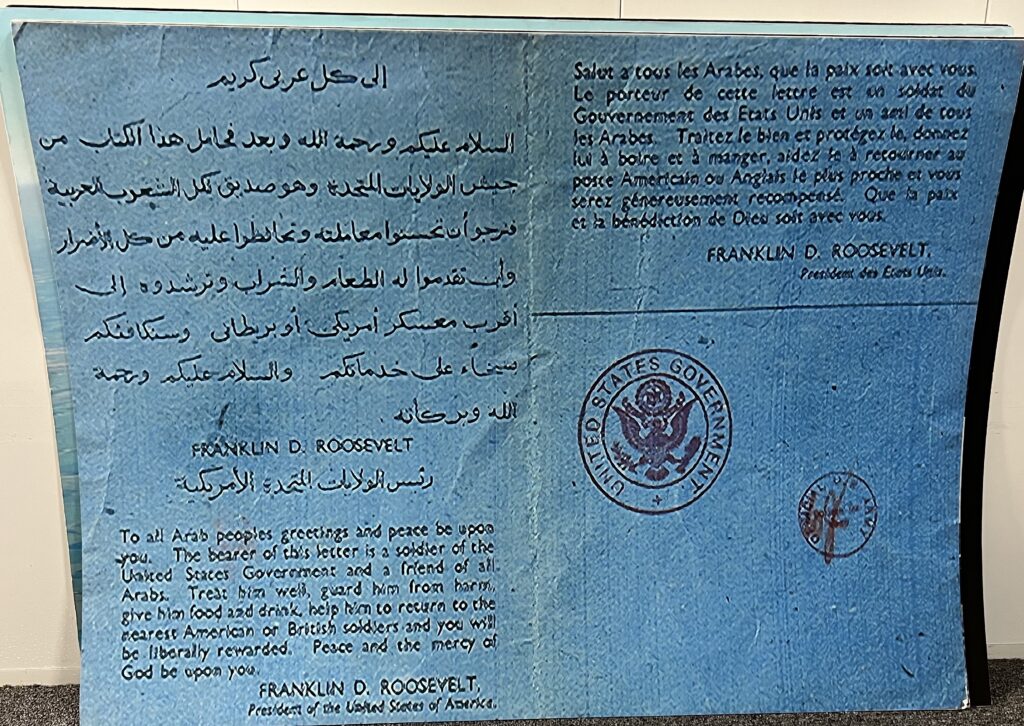
Item 30, Blood Chit, Photograph, 23×32, unframed (Packing and Shipping: Medium-$180)
“If we were shot down, we were instructed to present this small document, called a ‘blood chit’, to seek help. Written in English, French and Arabic, it promised a reward for helping the downed airman. In theory, it was a good idea. But I was shot down in the desert of Tunisia and presented it to a tribe of nomadic Taurags… and they couldn’t read!”
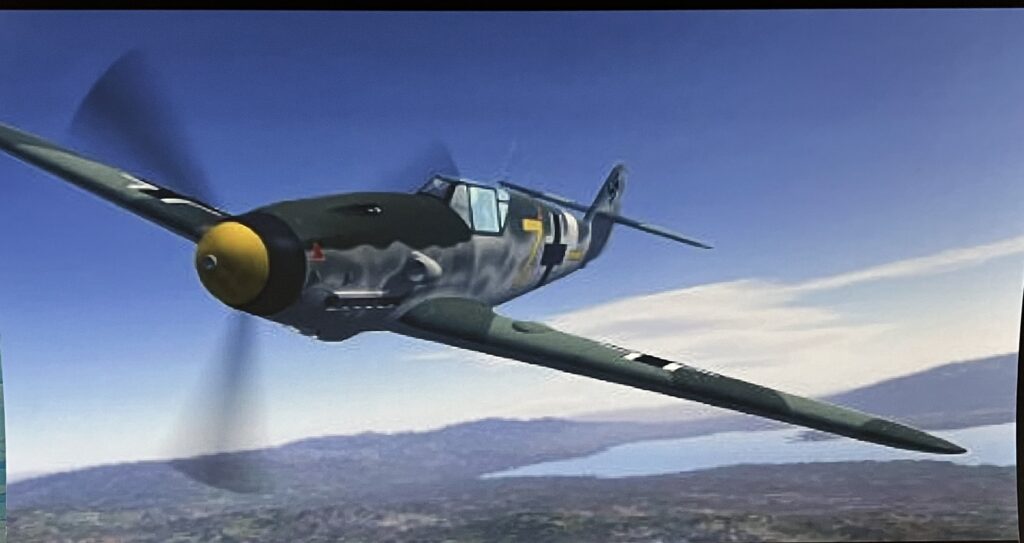
Item 31, ME-109, Photograph, 23×32, unframed (Packing and Shipping: Medium-$180)
“My tour of duty as a combat fighter pilot was in 1943, early in the war. I was based in North Africa and flew combat missions over Sicily, Sardinia and Italy. We fought against a variety of German and Italian aircraft. Our most dangerous opponents were the German pilots flying Messerschmitt ME109 aircraft. We were inexperienced pilots flying heavier, less maneuverable, twin-engine aircraft. Having fought their way across Europe, the German pilots were very experienced and their planes were more maneuverable. We were at a great disadvantage.”

Item 32, Combat Drawing by Fredric Arnold (drawn directly after the mission it depicts), Photograph, 23×32, unframed (Packing and Shipping: Medium-$180)
“We were losing pilots due to our inexperience and lack of training. We were literally ‘learning the job, on the job.’ After each of my 50 combat missions I returned to the barracks and painted an ink and wash drawing to illustrate an important lesson for the new guys. It was also a way to get images seared in my mind out of my head. This fellow, for example, left the security of the squadron to chase a single enemy ME109. He shot down the enemy plane, but made himself vulnerable and was killed. The lesson we impressed on new pilots was: ‘Stick with the squadron! We won’t win the war by trading one-for-one, guys!’ Later, my drawings were reprinted as training posters and were distributed throughout fighter squadrons.”
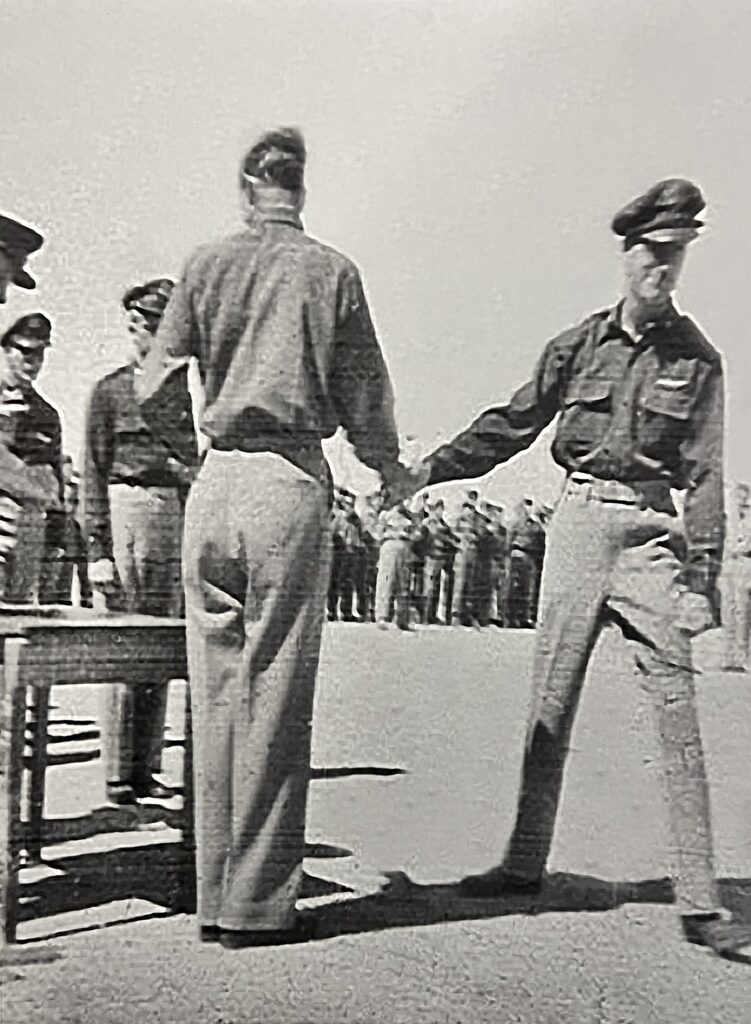
Item 33, Distinguished Flying Cross, Photograph, 23×32, unframed (Packing and Shipping: Medium-$180)
“Here is a photo of General Doolittle awarding me the Distinguished Flying Cross, a medal that signifies a pilot who ‘distinguished himself by single acts of heroism or extraordinary achievement.’ You can see from my posture that I had very little interest in medals. As far as I was concerned, combat was like taking out the garbage — it was a terrible job, but someone had to do it.”
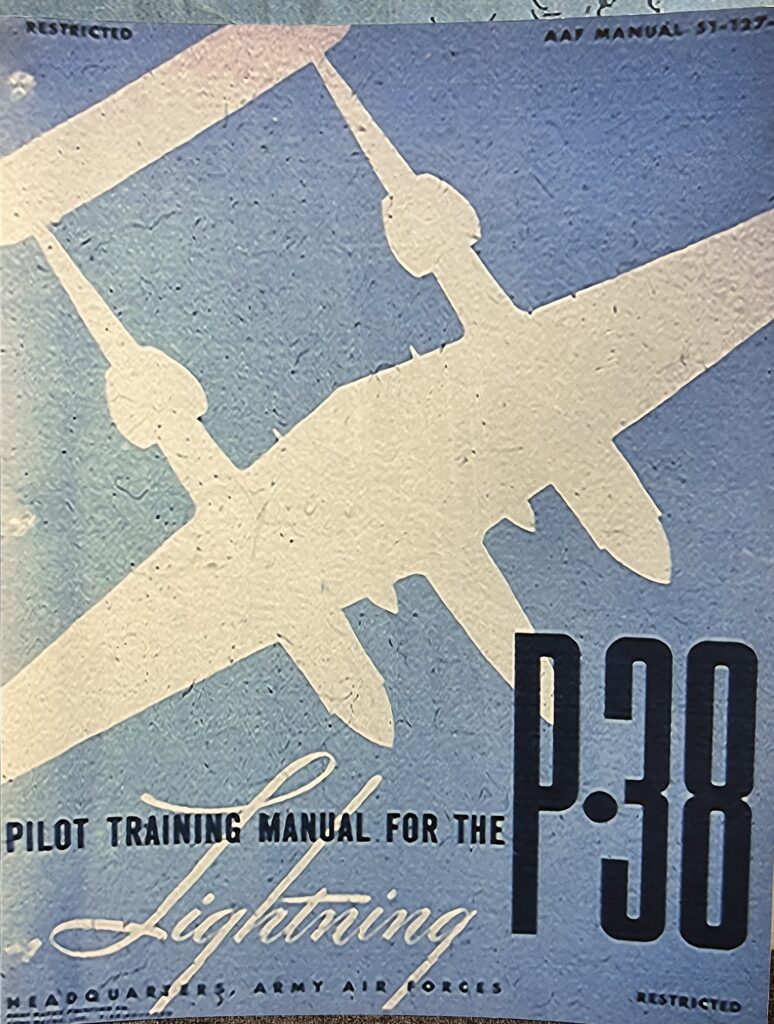
Item 34, P-38 Manual, Photograph, 23×32, unframed (Packing and Shipping: Medium-$180)
“I was among the first pilots to return from combat after surviving 50 missions. My combat drawings came to the attention of leadership and I was assigned to the Office of Flying Safety, where I was promoted to rank of Major at the incredibly young age of 23. During my time there, I wrote and illustrated the first training manuals for the P-38, P-47, P-51 and P-80, the first Air Force jet fighter. I was thrilled to know my work was saving lives instead of taking lives.”

Item 35, Death Toll, Photograph, 23×32, unframed (Packing and Shipping: Medium-$180)
“War’s toll on humanity cannot be imagined. For me, the loss of twelve out of our original group of fourteen is the most I can relate to. I simply cannot fathom the concept of thousands of deaths, let alone 60 million. It is truly mind boggling. In the decades since WWII, I have done all that I can to convey the catastrophic Human Cost of War… That is what motivated my public speaking, the Memorial Mural and, ultimately, my memorial sculpture, Lest We Forget: The Mission. I leave you with the hope and prayer that the peoples of the world learn to resolve their differences peacefully.”
OTHER ARTISTS IN DAD’S COLLECTION

Item 36, Strange Bedfellows, Rick Herter, Signed Limited Edition Lithograph, 34×21 (Packing and Shipping: Tube-$60)
Rick Herter is a well-known aviation artist. Upon reading Doorknob Five Two, he was moved to paint his conception of Dad’s final mission as described in the book. His beautiful oil painting was converted to a numbered limited edition lithograph.

Item 37, 5731, William T. Williams, Lithograph, 18×28, Description (Packing and Shipping: Medium-$180)
Dad was drawn to the artwork produced by the black community. Williams was a renowned Yale educated artist who garnered national recognition in the 1970’s. Dad was moved by this lithograph which was created to commemorate 1970 — the Jewish year of 5731.
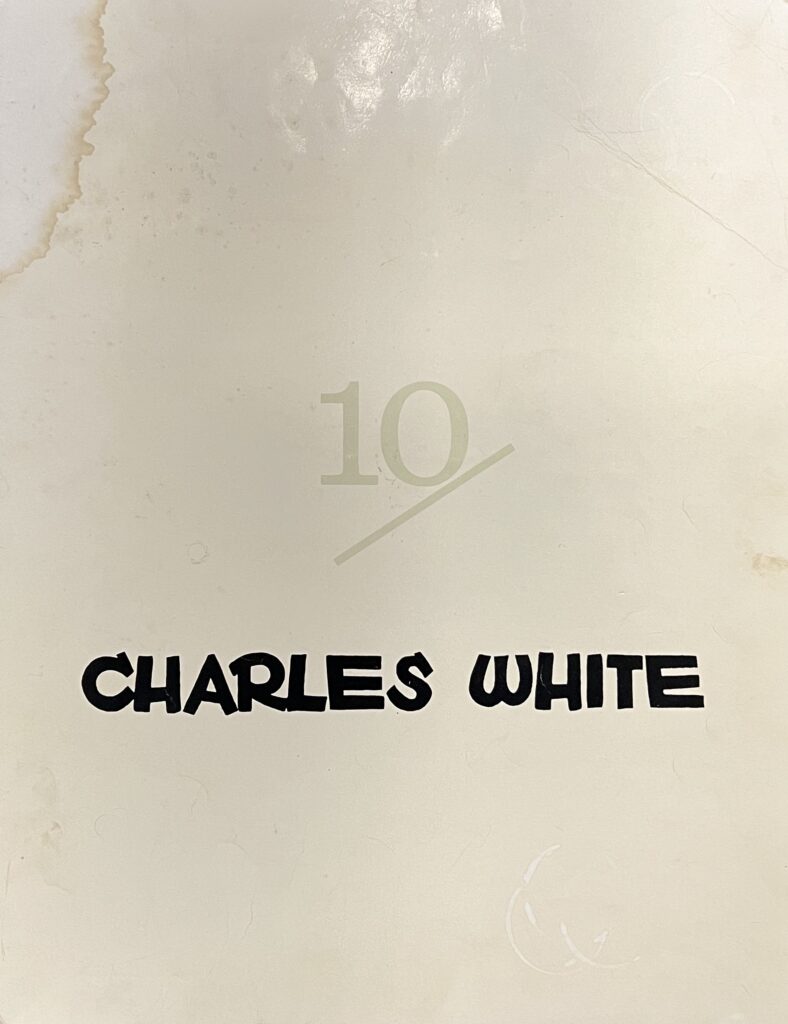
Item 38, 10/, Charles White, Nine Lithographs, 1961 (Packing and Shipping: Small-$110)
A fellow Chicago artist, Charles White became famous for depicting the life and times of blacks. His art was exhibited in museums around the world and was collected by Harry Belefonte, Sidney Poitier, Paul Robeson and Nate King Cole… to name a few. With an introduction by Harry Belefonte, this set of prints represents some of White’s best work. Dad loved White’s art.
This item includes the entire set of prints below.

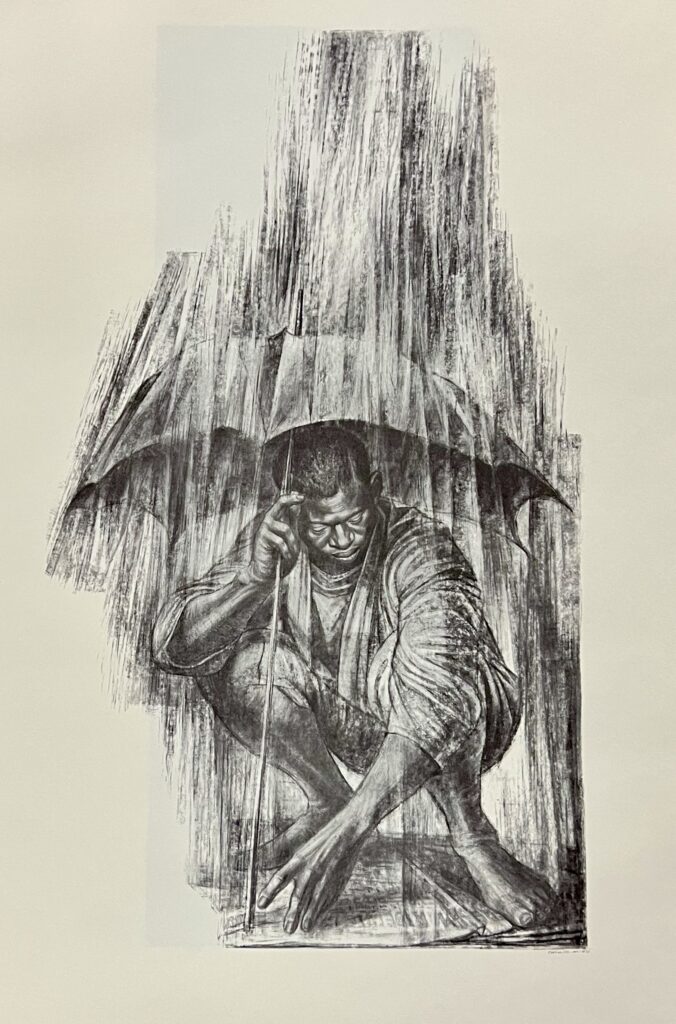
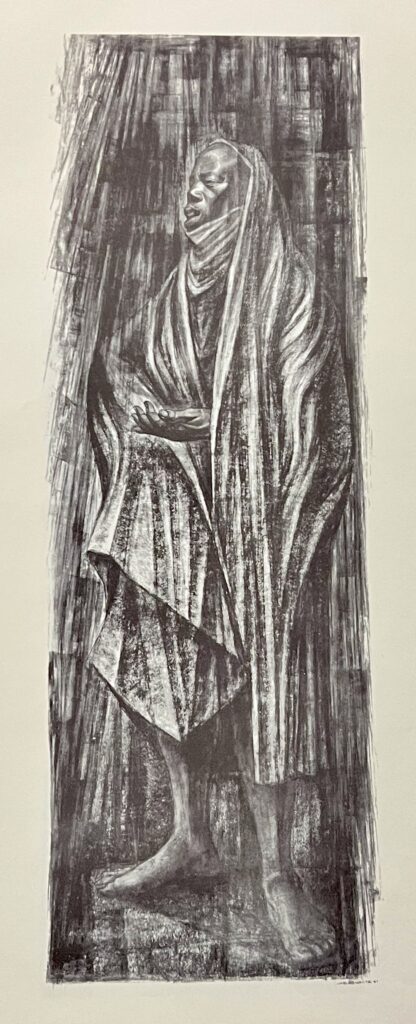



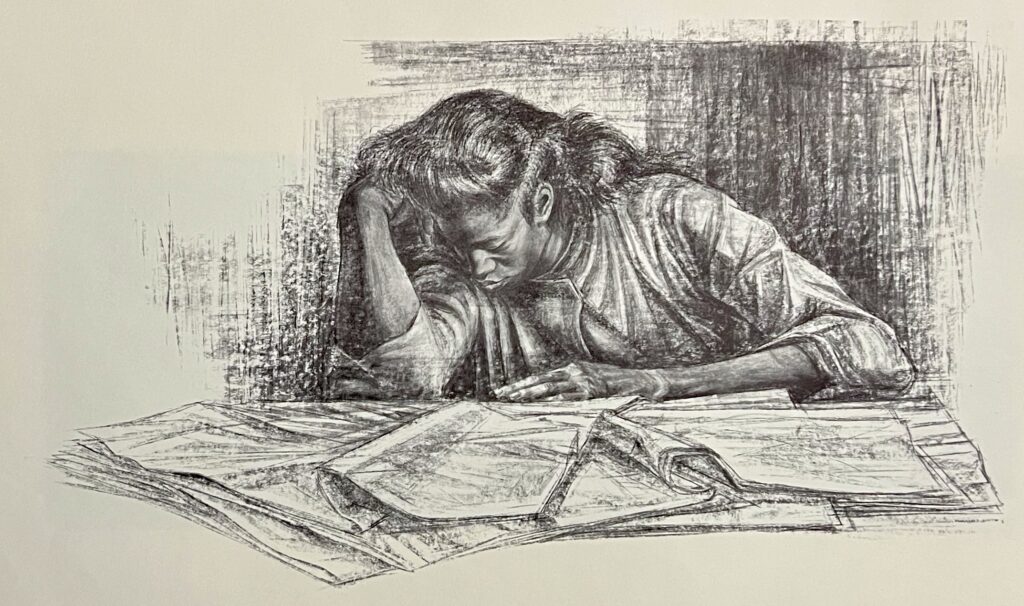
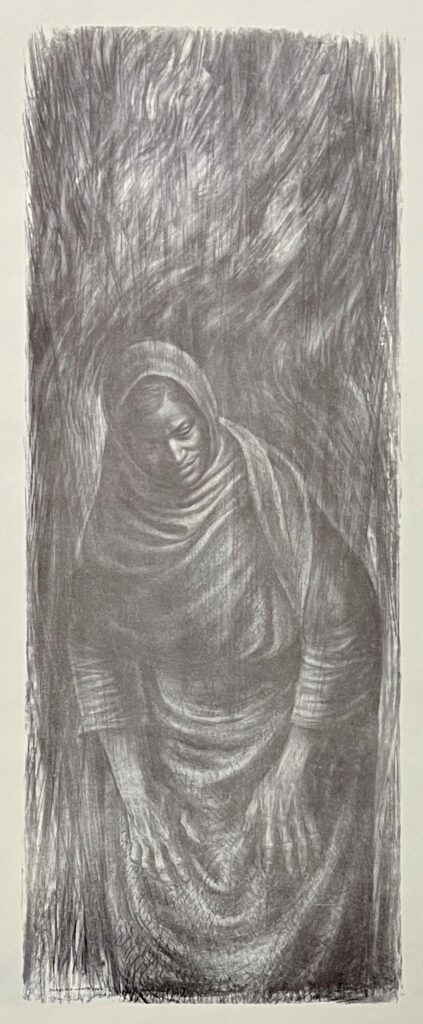
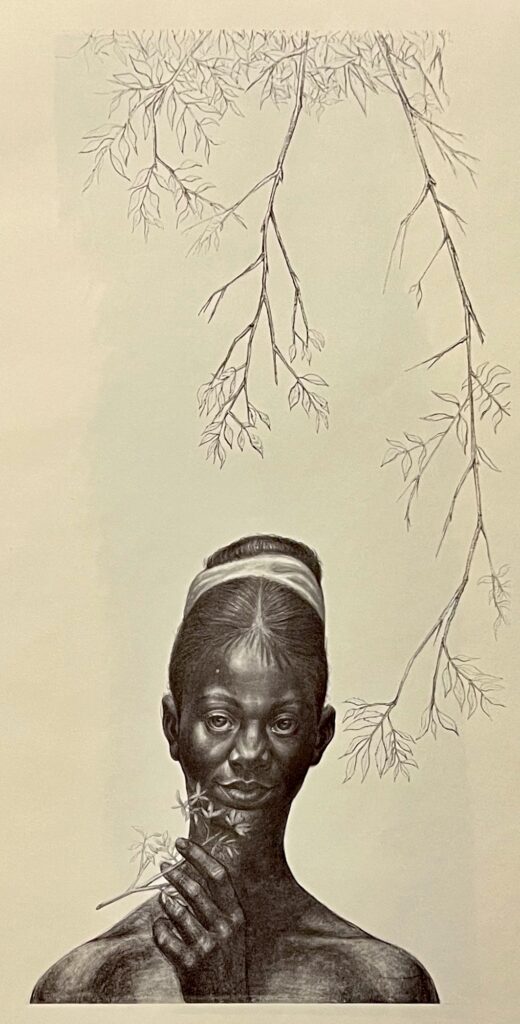
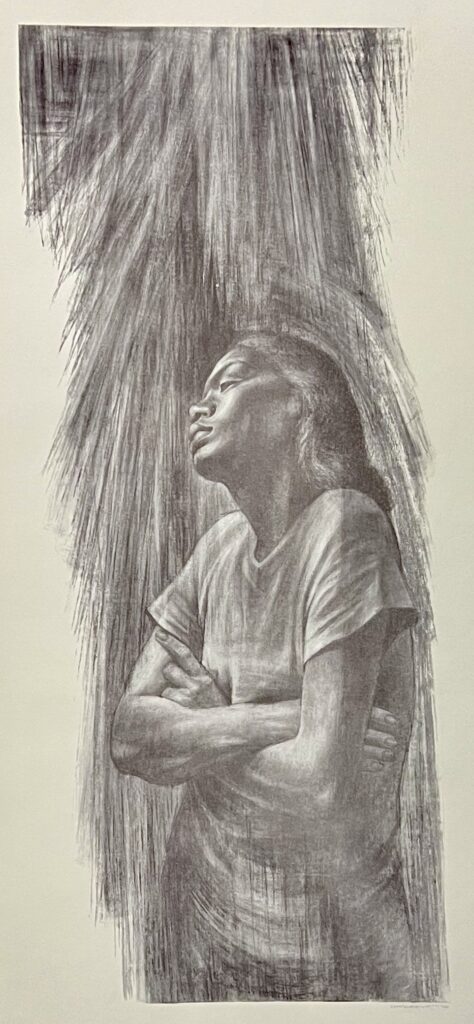
— end —